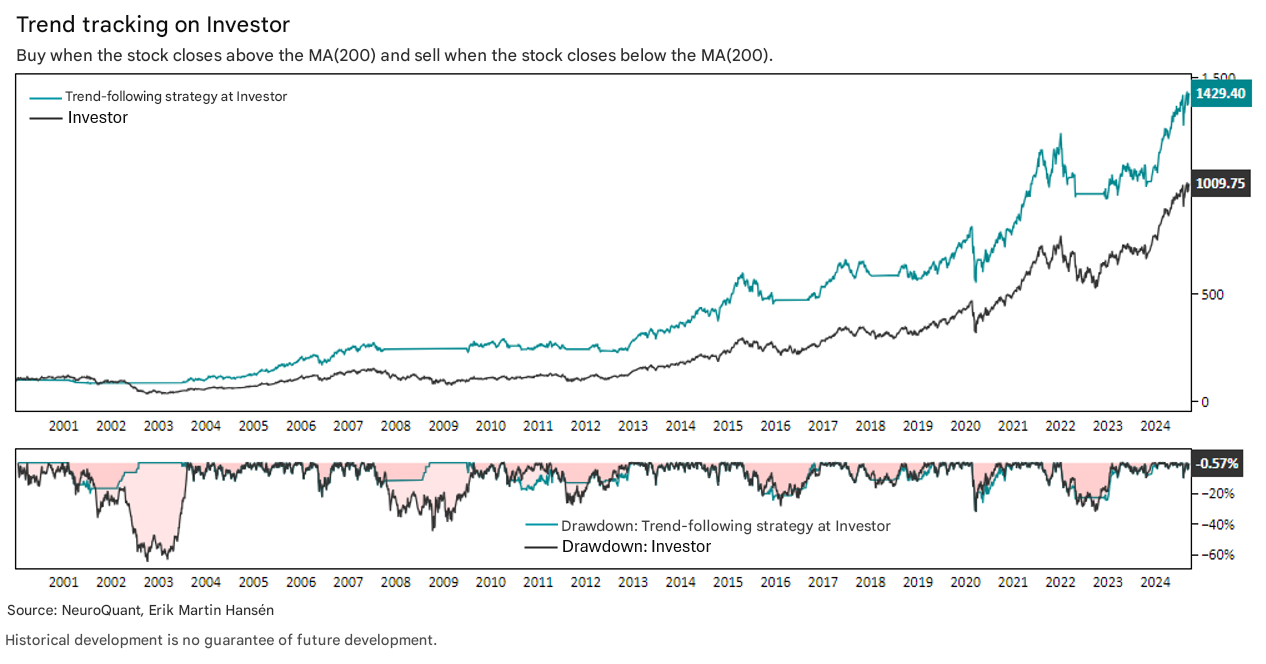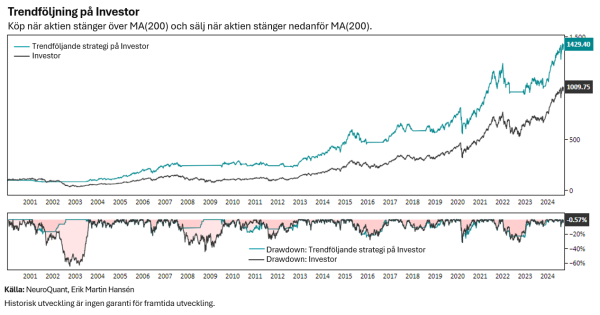Trend-following at Investor

Trend following is about accepting small losses and riding winners. Riding winners longer than most others manage to do. As an investor, it is very easy to sell winners too early. The strategy works well when the market offers sustained trends, but performs worse during periods of sideways movement or when trends are absent.
Let's show an example of the Investor stock where we use a simple trend-following strategy based on moving averages.
Example strategy at Investor
Concept:
- Follow the long-term trend until there is confirmation that it is broken.
- Minimize losses and maximize profits by following the trend.
Terms:
-
Buy when price closes above 12-month moving average
-
Sell when price closes below 12-month moving average
Result: The strategy has managed to minimize losses during downturns and has provided a good return. While the stock has had a maximum decline of almost 60%, the trend-following strategy has only had a maximum decline of just under 20%.
Over-optimization
However, this is a clear example of over-optimization. In the backtest, we have used a stock that we know has historically trended strongly. In backtesting, we have the advantage of having a track record, which makes it easier to create a strategy that works well on historical data. The challenge is to develop a strategy that will also perform well in the future, when conditions may be different.
We want to create robust strategies that work even if history does not repeat itself. It is common to see backtests showing impressive results because they have tested different parameters and chosen those that have worked best historically. However, adapting the strategy to historical noise can lead to the strategy failing in the future – something that primarily benefits the person who might sell the strategy.
Example of Tele2
Let's test the same trend-following strategy on Tele2. The results show that the strategy has given a significantly worse return than it did for, for example, Investor, because Tele2 has historically had weaker trends. However, we did not know this 20 years ago.
Despite this, the strategy has still outperformed a pure buy-and-hold strategy for Tele2. The reason is that the start date of the strategy coincided with the time just before the IT crash, and the strategy was outside of this downturn. This is something that can often be observed in connection with actors who sell backtests. By choosing a favorable start period for the strategy, the results can look better than they would over longer periods of time or under different market conditions.
Diversification
When trading trend-following or momentum strategies, we assume that we cannot predict which stocks will trend the strongest. Therefore, it is important to diversify and treat all holdings in the portfolio equally. By casting a wide net, we increase the likelihood of catching bigger winners.
Trade trend following like a pro
On the platform we offer entry and exit signals along with volatility-adjusted position sizes and tools to monitor stop losses. We also have a position calculator that can be used to calculate your own position sizes based on risk on capital or volatility on capital.
Open a free demo account
- Click here to read more about our strategies we offer (PDF).
- Click here to register a free demo account.





